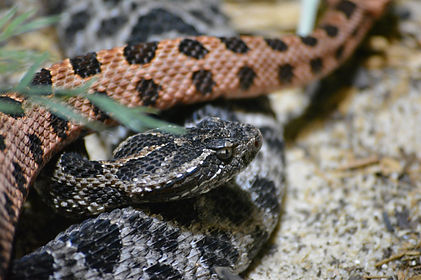
Snake Facts
Large Snakes
Despite being feared by many, large snakes such as the Python have resulted in only around 10 deaths in the US since 1990.
Important Note
When handling large constrictors such as a Python it's always a good idea to have a second person on hand just in case. Never underestimate the power of these amazing animals as they are basically one giant muscle.

Venomous Snakes
All of the dangerously venomous snakes in the U.S come from two families Elapidae (Coral Snakes) and Viperidae (Copperheads, Cottonmouths/Moccasins, Rattlesnakes) making identification somewhat simple. All venomous native species in Viperidae share an arrowhead-shaped head notably larger than the neck, heat sensing pits, and slanted or non-round eyes. All native members of Elapidae in the U.S. share a distinct pattern of red bordering yellow/white stripes while non-venomous mimics have a pattern of red bordering black stripes.
Important Note
This is true only of U.S. members of Elapidae, color patterns change on the Coral Snakes found in other countries.

Sleeping Snakes
Snakes do not experience "Hibernation" instead they experience brumation. During brumation, snakes remain awake and do not feed off of their fat stores as mammals do. Their metabolism is temperature controlled and thus slows allowing them to remain awake yet sluggish while not requiring the consumption of food.
Important Note
Feeding a snake that is in brumation is never a good idea as due to the drop in metabolism the food will often rot inside its stomach and may cause death. Snakes will often forgo eating in the fall to prepare for brumation.

Venom vs Poison
Most people don't know the difference between venom and poison venom must be injected to be harmful while poison must be ingested. Snake experts agree you could drink straight venom and providing it didn't find a path into your bloodstream it would pass harmlessly thru your system snakes are venomous and not poisonous.
